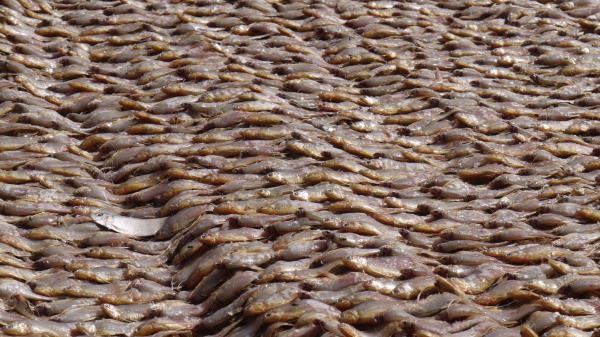
9 July 2018, Rome, Italy - Global fish production will continue to expand over the next decade even though the amount of fish being captured in the wild has levelled off and aquaculture's previously explosive growth is now slowing, says a new report by the Food and Agriculture Organization of the United Nations (FAO).
The latest edition of the agency's The State of World Fisheries and Aquaculture (SOFIA) report projects that by 2030 combined production from capture fisheries and aquaculture will grow to 201 million tonnes.
That's an 18 percent increase over the current production level of 171 million tonnes.
But future growth will require continued progress in strengthening fisheries management regimes, reducing loss and waste, and tackling problems like illegal fishing, pollution of aquatic environments, and climate change, the report adds.
"The fisheries sector is crucial in meeting FAO's goal of a world without hunger and malnutrition, and its contribution to economic growth and the fight against poverty is growing," said FAO Director-General José Graziano da Silva.
"The sector is not without its challenges, however, including the need to reduce the percentage of fish stocks fished beyond biological sustainability," he continued.
Trends in global fish supply
The State of World Fisheries and Aquaculture reports that 90.9 million tonnes of fish was captured in the wild in 2016 — a slight decrease of 2 million tonnes from the year before, mainly due to periodic fluctuations in populations of Peruvian Anchoveta associated with El Niño.
Generally, the amount of fish being captured in the wild plateaued starting in the 1990s and has remained largely stable since.
Despite that fact, the world has for decades been consuming ever greater amounts of fish - 20.3 kg per capita in 2016 versus just under 10 kg/pc in the 1960s — thanks in no small part to increased production via aquaculture, a sector which expanded rapidly during the 1980s and 1990s.
In 2016, production from aquaculture reached 80 million tonnes, according to SOFIA 2018 — providing 53 percent of all fish consumed by humans as food.
While aquaculture's growth has slowed — it experienced 5.8 percent annual growth between 2010 and 2016, down from 10 percent in the 1980s and 1990s — it will still continue to expand in the coming decades, especially in Africa.
Efforts to reduce the amount of fish being discarded at sea or thrown out post-capture — for example by using discards and trimmings to produce fishmeal — will also help meet ongoing increases in demand for fish products.
The status of wild fish stocks
Some 59.9 percent of the major commercial fish species that FAO monitors are now being fished at biologically sustainable levels, while 33.1 percent are being fished at biologically unsustainable levels — a situation that SOFIA 2018 describes as "worrying." (The other 7 percent are underfished).
Just 40 years ago, 90 percent of FAO-monitored fisheries were being utilized at biologically sustainable levels, and just 10 percent were being fished unsustainably.
These trends do not necessarily mean that no progress has been made toward achieving Sustainable Development Goal 14, which calls on the international community to effectively regulate fish harvesting end overfishing, illegal fishing, and destructive fishing practices, and to implement science-based management plans aimed at restoring stocks.
But FAO's report warns that the world has diverged in its approach to sustainable fisheries, with worsening overcapacity and stock status — too many boats chasing too few fish — in developing countries offsetting improved fisheries management and stock statuses in developed ones.
Counteracting this will require building effective partnerships, particularly in policy coordination, financial and human resource mobilization and deployment of advanced technologies (e.g. for monitoring fisheries).
Other challenges
Climate change and pollution are also cause for concern.
While research suggests that climate change might cause overall global fish catch levels to vary by under 10 percent, significant shifts in where fish are caught are anticipated, SOFIA 2018 notes. Catches are likely to drop in many fisheries-dependent tropical regions and rise in temperate areas of the north.
Shifts in the distribution of fisheries will have major operational, managerial, and jurisdictional implications, the report says. Research will be needed to develop strategies for allowing both fisheries and the species they exploit to adapt smoothly to climate change.
Also needed: strengthened collaboration to address the problems that abandoned fishing gear debris and pollution by microplastics are causing in aquatic ecosystems. Priority should be given to preventive measures that reduce marine litter and microplastics, efforts to upgrade recycling schemes to "circular economies" as well as phasing out single-use plastic, says FAO's report.
Key numbers from The State of World Fisheries and Aquaculture 2018
The State of World Fisheries and Aquaculture 2018 highlights how important fishing and fish farming are for people's livelihoods, including millions of families belonging to some of the world's poorest communities.
Worldwide, nearly 60 million people (14 percent of them women) are directly employed in fisheries and aquaculture sector, whose first sale production value in 2016 added up to $362 billion.
Fish account for about 17 percent of animal protein consumed by the global population and overall provide about 3.2 billion people on the planet with nearly 20 percent of their animal protein. And fish represents a highly nutritious food especially helpful in counteracting micronutrient deficiencies.
Global trends can mask the crucial dietary contributions fish make in poorer countries, however. For example, in Bangladesh, Cambodia, Gambia, Ghana, Indonesia, Sierra Leone, Sri Lanka and some small island development states, fish supplies fifty percent or more of people's protein intake.